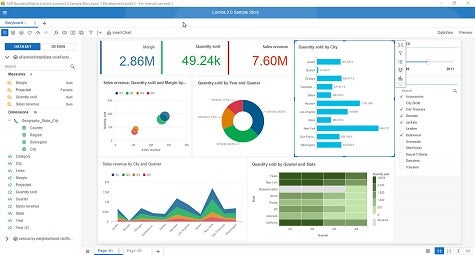At the SAP Sapphire Now and ASUG 2017 conference today, SAP moved to improve the analytics capabilities in both its ERP application and the dedicated suite of analytics applications it provides.
In addition, SAP announced it will be collaborating with IBM to integrate Watson with the Internet of Things (IoT) elements of the SAP Leonardo portfolio of software and the SAP Ariba business-to-business procurement network.
An update to SAP S/4HANA ERP application SAP delivers as a cloud service embeds a range of machine learning algorithms that improve the predictive analytics that can be provided in the core application. Other new capabilities include support for a conversational interface, dubbed SAP CoPIlot, that can be used to query data, and a mobile application, dubbed SAP Project Companion, a mobile application through which end users can receive push notifications about specific events.
A separate update to SAP Analytics Cloud adds a new mobile app for Apple iOS devices, live connections to the SAP BW/4HANA data warehouse, R scripting, enhanced visual linking, data preparation functions for all user types, smart discovery features including simulations and scoring, a smart insight feature to automatically propose visualizations, and prebuilt industry and line-of-business content.
SAP Analytics Cloud was formerly known as SAP Business Objects Cloud. Mike Flannagan, senior vice president for analytics and executive board member for SAP, says the Business Objects moniker was creating confusion among customers because SAP Analytics is a completely different application and code base than BusinessObjects business intelligence (BI) software that SAP has been selling for years.
A new update SAP BusinessObjects now sports a new user interface, while a previously separate designer studio tool has been embedded into version 2.0 of the company’s Lumira data visualization tool. To make it easier to integrate Business Objects with other sources of data, SAP also announced an alliance with ZoomData under which microservices will be employed to make it simpler for users of the SAP business intelligence software to access a broad mix of data types and sources.
Finally, SAP today also announced a SAP IT Operations Analytics application for IT operations that is optimized of analyzing logs.
“We couldn’t find one that met our needs,” says Flannagan. “So the internal IT organization at SAP built their own.”
While SAP continues to offer a broad range of analytics applications that can be purchased separately, long term, SAP is betting that analytics will increasing be embedded into transaction processing applications such as S/4HANA. Enabled by an in-memory HANA database that can process both types of data simultaneously, modern applications will increasingly surface insights based on analytics and machine learning algorithms in real time. How those applications will transform business processes remains to be seen. But the one thing that is for certain is that mean time between an event and a subsequent business decision is getting a lot smaller with each passing day.



